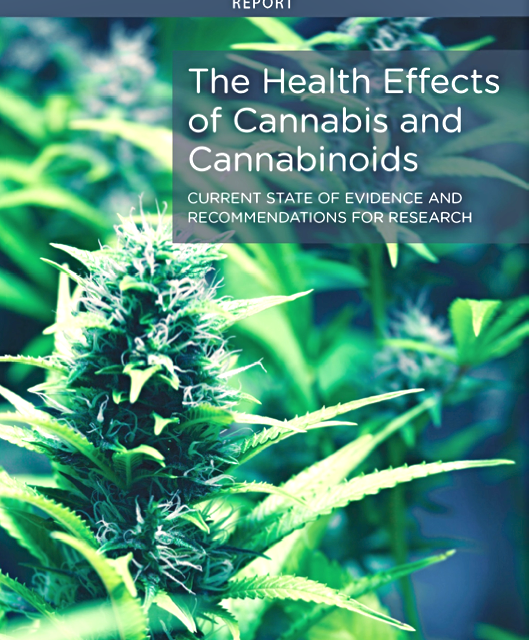By Fred Gardner The report we are calling “IOM 2.0” —and whose authors acknowledge the 1999 Institute of Medicine Report on Cannabis as its predecessor— was published by the National Academies of Sciences, Engineering and Medicine. The institutional name change occurred in 2016 as part of some bureaucratic restructuring.
The 2017 report, “The Health Effects of Cannabis and Cannabinoids The Current State of Evidence and Recommendations for Research,” is based on papers published in peer-reviewed journals since 1999. We will keep calling it IOM 2.0 because the 400-page compendium reminds us of how little —or far, depending on your POV— the experts’ understanding has advanced since 1999. As explained in the preface:
Reports document the evidence-based consensus of an authoring committee of experts. Reports typically include findings, conclusions, and recommendations based on information gathered by the committee and committee deliberations. Reports are peer reviewed and are approved by the National Academies of Sciences, Engineering, and Medicine.
Some tidbits from the text as I scroll through the opening pages to find the line I want to share with the SCC:
“Based on a recent nationwide survey, 22.2 million Americans (12 years of age and older) reported using cannabis in the past 30 days and between 2002 and 2015 the percentage of past month cannabis users in this age range have increased steadily from 6.2 to 8.3 percent…”
Though stated as a statistical fact, the supposed increase in cannabis use could reflect an increased willingness to answer yes to a question about use.
“A lack of scientific research has resulted in a lack of information on the health implications of cannabis use, which is a significant public health concern for vulnerable populations such as adolescents and pregnant women.”
Seems like they’ve made up their mind in advance on these categories.
“Unlike other substances, such as alcohol or tobacco, whose use may confer risk…”
Guilt by association… Here’s the money shot:
The scientific literature on cannabis use has grown substantially since the 1999 publication of Marijuana and Medicine. The committee conducted an extensive search of relevant databases, including Medline, Embase, the Cochrane Database of Systematic Reviews, and PsycINFO and initially retrieved more than 24,000 abstracts that could have potentially been relevant to this study. These abstracts were reduced by limiting articles to those published in English and removing case reports, editorials, studies by “anonymous” authors, conference abstracts, and commentaries. In the end, the committee considered more than 10,700 abstracts for their relevance to this report.
Given the large scientific literature on cannabis, the breadth of the statement of task, and the time constraints of the study, the committee developed an approach that resulted in giving primacy to recently published systematic reviews (since 2011) and high-quality primary research for eleven groups of health endpoints. For each health endpoint, systematic reviews were identified and assessed for quality using published criteria; only fair- and good- quality reviews were considered by the committee. The committee’s conclusions are based on the findings from the most recently published systematic review and all relevant fair- and good- quality primary research published after the systematic review. Where no systematic review existed, the committee reviewed all relevant primary research published between January 1, 1999 and August 1, 2016. Primary research was assessed using standard approaches (e.g., Cochrane Quality Assessment, Newcastle-Ontario scale) as a guide.
The Case for Case Reports
Although the IOM 2.0 authors are dismissive of case reports, Dr. Raphael Mechoulam is not. A few months ago we got an email from the Israeli filmmaker Zach Klein with a graphic from his editing machine:
I’m editing my documentary about autism (and cannabis) and I think that Mechoulam is looking at O’Shaughnessy’s. Picture is attached. Did you publish something about the subject?
The page from O’Shaughnessy’s that Mechoulam was looking at ran in our Summer 2009 issue, which contained two brief case reports by Philip Denney, MD. Evidently a colleague of Mechoulam’s had torn out and folded the page with Denney’s material, put it in an envelope, and mailed it to Mechoulam, who filed it for future reference. Which goes to show that the real scientist takes seriously material that elitists dismiss as lower than “low-quality” evidence. Raphael Mechoulam is a real scientist and his instincts are democratic.
I sent Klein the relevant pdf from our Summer ’09 issue and cced Mechoulam, whose gracious reply included this comment:
“As regards autism. We also have excellent results —with pure CBD. High doses (300 mg/day) seem to be needed.”
It’s a revealing coincidence that IOM 2.0 is published just as the US government is telling us, the people, to accept as proof — because the CIA and 17 other “security” agencies find it credible— evidence that they can’t show us for “security” reasons.







